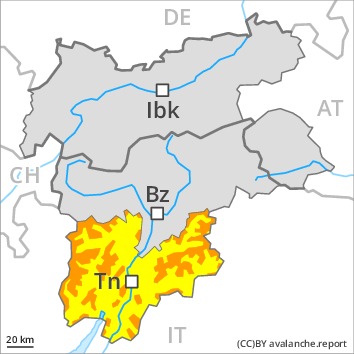
Danger level
 | treeline
|
Avalanche Problem
 | | Wind-drifted snow |
|  | |  |
 | | Gliding snow |
|  | |  |
 | | Persistent weak layer |
|  | |  |

Fresh wind slabs represent the main danger. At elevated altitudes a considerable avalanche danger will still be encountered.
The new snow and wind slabs remain very prone to triggering in all aspects above the tree line. This applies in particular on very steep slopes, and adjacent to ridgelines. The fresh wind slabs can be released easily. or in isolated cases naturally, in all aspects and generally above the tree line. The number and size of avalanche prone locations will increase with altitude.
Weak layers in the old snowpack are difficult to recognise. Avalanches can in isolated cases penetrate deep layers and reach quite a large size.
Backcountry touring calls for extensive experience in the assessment of avalanche danger and careful route selection. A latent danger of gliding avalanches exists. Areas with glide cracks are to be avoided as far as possible.
Snowpack
dp.6: cold, loose snow and wind
As a consequence of a moderate to strong northerly wind, clearly visible wind slabs formed especially adjacent to ridgelines. This also applies in gullies and bowls below the tree line. The fresh wind slabs are lying on soft layers in all aspects. The various wind slabs have bonded poorly together.
Faceted weak layers exist in the centre of the snowpack in particular above the tree line.
Towards its base, the snowpack is moist and its surface has a melt-freeze crust, in particular at low and intermediate altitudes.
Tendency
A latent danger of gliding avalanches exists. As a consequence of low temperatures the snowpack can not consolidate, especially in the vicinity of peaks and at high altitude. Fresh wind slabs are to be evaluated with care and prudence.











